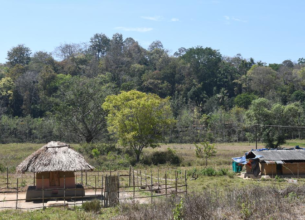A grave mistake in Great Nicobar
23, Mar 2023

Prelims level : Environment
Mains level : GS-III Environment - Biodiversity & Environment conservation.
Why in News?
- The Ministry of Environment, Forest and Climate Change (MoEFCC) has given clearance to a mega project in the southern part of Andaman and Nicobar Islands.
- The NITI Aayog will steer the project and the Andaman and Nicobar Islands Integrated Development Corporation is the project proponent.
- The project is titled ‘Holistic Development of Great Nicobar Island’. Its objective is to develop:
- An international transshipment port of 14.2 mTEU cargo capacity at Galathea Bay
- An international airport for 4000 passengers (during peak hours)
- A 450 MVA gas and solar-based power plant
- An ecotourism and residential township of nearly 160 sq km
- Moreover, offices of multinational corporations will be established by clearing a million trees in tropical rainforests.
Background Details:
- The Great Nicobar is located approximately 1650 km from Chennai and 40 nautical miles from the international shipping route.
- The project to establish a transshipment facility and free trade zone on the island began in September 2020.
- In December 2021, the draft Environment Impact Assessment (EIA) was placed in the public domain for comments and discussion. It was followed by quick approvals, clearances, exemptions, and de-notification.
- The Great Nicobar Island has a population of around 8000. The island will attract around three lakh people, once the project is completed.
- The island is spread over 900 sq km and was declared a biosphere reserve in 1989. In 2013, it was included in UNESCO’s Man and Biosphere Programme.
- Notably, more than three-fourths of the island is designated as a tribal reserve under the Andaman and Nicobar Islands (Protection of Aboriginal Tribes) Amendment Regulation.
Associated Concerns:
- The environmental and ecological cost of the urbanization project in Great Nicobar (a region known for marine and terrestrial diversity) is significantly higher. Thus, it is argued that calling it ‘holistic’ would be a misnomer.
- It is suggested that the objective to convert the island into a commercial hub is nothing less than an ‘ecocide’.It will impact the rights of vulnerable tribal communities that depend on forests for survival like the Shompen and Nicobarese.
- As per the EIA report, compensatory afforestation will be carried out in Madhya Pradesh and Haryana. It should be noted that far-field afforestation is not much significant.
- The project will destroy vast stretches of coral reefs.
- The report recommends the transplantation of corals but transplanted corals have a low survival rate and are susceptible to bleaching.
- The Great Nicobar is tectonically unstable. It is located in close proximity to the Ring of Fire and the Tsunami of 26 December 2004.
- The EIA report fails to mention scientific studies before and after the 2004 earthquake. The coastline sank several meters during the earthquake.
- The satellite studies show that the region is gradually regaining its original height. The report disregards this tectonic instability around the island.
Conclusion:
- It should be noted that growth in terms of GDP makes no sense if it results in the irretrievable loss of natural capital.
- India is championing conservation, sustainability, and green development models on international fora. But unsustainable projects will dilute such efforts.










